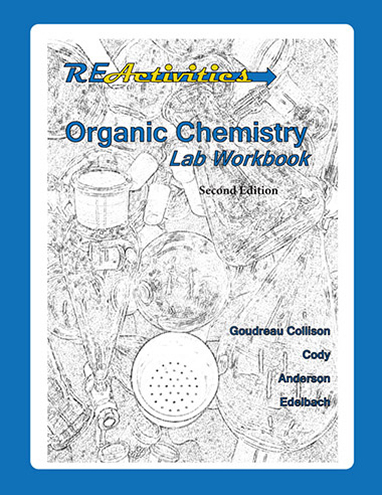
Second Edition
Availability: In Stock/Ready to Ship.
Suggested retail price shown above.
For discounted Bookstore or School District bulk orders: Contact Us
REActivate independence in lab learning! Organic chemistry REActivities (Second Edition) is a lab workbook designed to be student-guided and not instructor taught. Students are encouraged to self-guide, and interact with the instructor to answer questions and request help where needed. Independent inquiry is encouraged as students must read the worksheets and follow the instructions step-by-step as they go along.
During the labs, students will have time to:
Practice:
When learning techniques for the first time, students will get time to practice before running the experiment, and recording in their lab notebook. It's not fair to ask that students' first-ever attempt is recorded, so the workbook encourages students to have the room and comfort to make mistakes and know that learning techniques takes time and practice.
Work with Peers:
In science, it's important to talk about and compare your results with a lab partner. Students are often asked during a REActivity to stop and work with partners on concept questions, or to report and compare results with lab mates. It's difficult to gauge your success for a given task if you have nothing with which to compare.
Ask Questions:
The flow of these REActivities allows for the instructor to more freely wander around the lab and help students. There will be certain instances where students will need the instructor's approval before moving forward.
Introduction
• About REActivities
• Waste Management
• Communal Pool of Compounds
Techniques
• First Day of Lab
• Recrystallization (single solvent)/Melting Point
• Recrystallization (solvent pair)
• Thin Layer Chromatography
• Column Chromatography
• Stereochemistry
• Liquid — Liquid Extraction
• NMR and IR
• Distillation
• Predicting Organic Reactions: SN1 / SN2
Reactions
• Troubleshooting an Organic Reaction
• Bromination of Cinnamic Acid
• Elimination of Dibromo-cinnamic Acid
• TEMPO Oxidation of Benzyl Alcohol
• Wittig Reaction of Benzaldehyde
• Saponification of trans-Cinnamate
• Perkin Condensation of Benzaldehyde
Appendix
Supplemental NMR Tutorial
Fractional Distillation